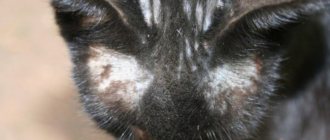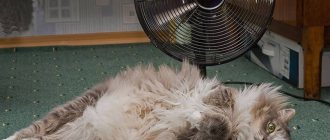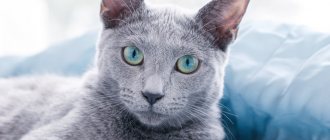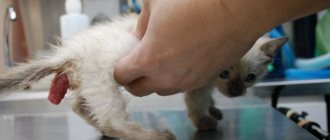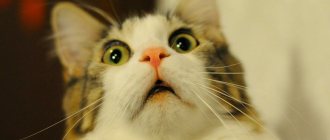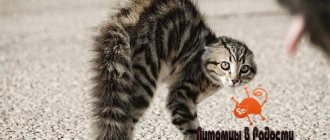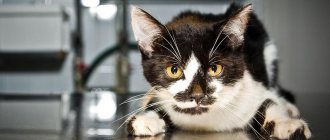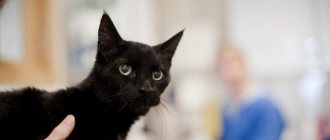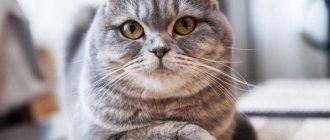4229Pavel
Volvulus is a rather dangerous phenomenon for both humans and animals. You should take immediate action if you see all the symptoms of volvulus. In cats and dogs, this problem should be correctly diagnosed, because, unlike humans, our pets cannot tell what hurts them and where. When intestinal volvulus occurs, you should react quickly and correctly recognize all clinical signs. The life of the animal largely depends on the speed of diagnosis and action. This problem leads to tissue death, a sharp deterioration in the cat’s condition, and disruption of the blood supply to the gastrointestinal tract.
What is the disease
Intestinal volvulus is the twisting of the intestinal loop around the mesenteric axis or the rotation of one of its sections relative to another. It entails the closure of the intestinal lumen. Large arteries are compressed, resulting in disruption of nutrition and blood supply to the intestinal wall. Intestinal obstruction forms, the bloodless tissues gradually necrotize (die). If urgent measures are not taken, the pathological process will be complicated by sepsis and peritonitis. It will be impossible to save the animal.
In cats, the disease has three development options:
- volvulus of the small intestine (a significant part of the intestine located between the stomach and large intestine);
- volvulus of the colon and cecum;
- eversion of part of one intestine into the lumen of another (intussusception).
Professional help
With intussusception, X-ray images show a clear picture of stretching of the small intestine. There may be liquid in the cavities. A specialist will not be able to tell the owners for sure that the pet has bloat; only surgery will give an accurate answer. Unfortunately, many mustachioed creatures die before they can reach the clinic with their owners.
If the pet was successfully delivered, then the animal will undergo surgery at the veterinary clinic - this is the only way to rid it of the problem.
During the operation, the specialist must carefully examine all parts of the intestine and give the twisted area a normal anatomical position. Tissues that have undergone necrosis will be removed.
If the lesion has affected most of the tissues, then complete removal of the small intestine is possible; in this case, the mustachioed creature will need maximum care, since it will need to be constantly taken to courses of maintenance therapy and its nutrition will be strictly monitored for the rest of its life.
Causes of the disease
Experts believe that the main causes of the disease are congenital anomalies in the development of the intestine, mesentery (the ligament with which the hollow organs of the abdominal cavity are fixed to its wall) and the adhesive process in the intestine.
The onset of the pathological process can be provoked by several factors. They are, as it were, secondary causes of the disease:
- a sharp change in intra-abdominal pressure that occurs during significant physical activity (running, outdoor games) on a full stomach;
- improper diet, in which prolonged hunger is replaced by heavy feedings, sharply increasing intestinal motility;
- entry of a foreign body into the kitten’s intestines due to accidental ingestion;
- use of low quality feed;
- long-term bowel dysfunction (constipation);
- tumor diseases of the gastrointestinal tract.
The risk group usually includes kittens that are not yet one year old. But even an adult animal can develop intestinal pathology if one or more risk factors are present.
Intestinal obstruction in cats - symptoms, treatment, medications, causes
This phenomenon means a violation of the movement of food mass through the intestines. Intestinal obstruction may be associated with impaired innervation, vascular disorders, spasm of smooth muscles, obstruction of the intestinal lumen or mechanical compression of intestinal loops.
Constipation and intestinal obstruction are not the same thing, although sometimes the concepts are confused. This pathology does not belong to the category of independent ones. It is considered a polyetiological syndrome. That is, changes caused by some other illness.
Depending on the morphological, anatomical changes, and the course of the disease, obstruction is classified:
- vascular, caused by infarction of intestinal tissue;
- dynamic (spastic or paralytic);
- mechanical (strangulation, obstruction, mixed).
Strangulation refers to intestinal volvulus, strangulation, or formation of nodes.
The obstructive form of the pathology hides blockage of the intra- or estrainterstitial nature of the intestinal lumen.
The mixed form refers to adhesions and the introduction of one intestinal fragment into another (intussusception).
Complete obstruction
This syndrome is fraught with severe intoxication, intestinal necrosis, peritonitis and death of the animal. Obstruction leads to the fact that feces cannot be removed and decay products begin to be absorbed by the mucous lining.
If the obstruction is caused by a foreign chemically active object, it decomposes/oxidizes under the influence of the digestive juices of the cat’s body. This causes the animal to be poisoned.
Necrosis or necrosis of intestinal tissue develops due to bleeding of its area in the affected area.
Partial obstruction
Partial disruption allows some gases and liquids to escape. And it leads to the proliferation of putrefactive flora in the intestines and the death of symbiont bacteria. This disrupts the absorption of nutrients and leads to inflammation of the intestinal walls.
The first thing that should alert a cat owner and force him to take the cat to the veterinary clinic is the pet’s refusal to eat. Moreover, the animal does not even look in the direction of its favorite treat.
In addition, the cat has:
The animal may try to go to the toilet, sulk, meow pitifully, or grunt. But the effectiveness of attempts is zero if there is complete obstruction. The cat can get rid of some gases and intestinal contents if the obstruction is incomplete.
When trying to palpate the abdomen, the cat will try to wriggle out or meow pitifully due to pain. As the disease progresses, the pet becomes weak and lethargic. drowsiness and apathy develop, vomiting feces begins, body temperature drops, and dehydration begins.
In this case, the cat's life is in danger and immediate veterinary intervention is required.
Each form of obstruction is caused by its own causes, from a foreign body to pathology of internal organs. It can be congenital or acquired. The congenital form is observed in kittens with anomalies in the development of the intestinal tube.
Obstruction of vascular origin
Vascular obstruction occurs due to acute acute obstruction of intestinal vessels. This may be a consequence of thrombosis or embolism.
Spasmodic obstruction
This type of syndrome is caused by a reflex spasm of the intestines, which occurs as a response to pain when:
- helminthiasis;
- getting various objects into the intestines;
- abdominal injuries;
- acute cardiac pathology (heart attack);
- rib injury (fracture);
- an attack of acute pancreatitis;
- pneumo-, hemothorax, some types of pneumonia, pleurisy;
- colic (renal, biliary), etc.
In addition, spasms can be caused by neurological pathology, including head injury, stroke, or spinal cord injury. Dyscirculation can also be the cause of this type of pathology.
Paralytic variant of the syndrome
Its cause is paresis or paralysis of the intestines, which develops as a result of operations affecting the abdominal cavity, peritonitis, poisoning with certain medications, salts of heavy metals, and foodborne toxic infections.
Intestinal obstruction
This variant of the syndrome is caused by gallstones and intestinal stones, helminthic balls, hairballs, intraluminal neoplasms, a foreign object, compression of the intestinal walls by a tumor that has affected nearby organs.
Strangulation
This pathology develops with a strangulated hernia or with volvulus, with intussusception or nodulation on intestinal loops. This pathology can be a consequence of cicatricial changes, increased intra-abdominal pressure, fusion of intestinal loops, and adhesions. And also by fasting for a long period of time, which ended with excessive absorption of food.
Diagnosis comes down to a visual examination of the animal, palpation of the abdomen, drawing blood and urine for analysis, and contrast radiography.
Treatment for the syndrome can be:
The first method is applicable for blockage of the intestinal lumen with insoluble objects (cellophane, plastic), intussusception, tumors, necrosis of the intestinal walls.
The conservative method is applicable for spastic colitis of various etiologies and helminthic infestations.
In this case apply:
- medications to treat the underlying disease;
- antispasmodics;
- oil enemas;
- if necessary, analgesics and antibiotics;
- to restore microflora - probiotic agents;
- anti-inflammatory drugs;
- immunostimulating substances.
The diet of a sick cat should be light, preferably liquid; he needs rest, care, and plenty of fluids. In case of dehydration, drip infusion of solutions is necessary.
Source: https://razvitielife.ru/bolezni-u-detej/zdorovaya-semya/14327-kishechnaya-neprokhodimost-u-kotov-simptomy-lechenie-preparaty-prichiny-poyavleniya-nashi-luchshie-druzya
Symptoms
Volvulus in a cat has a variety of symptoms, which are especially pronounced if the small intestine is involved in the process. The animal begins to suffer from acute cramping pain. It cannot tell the owner about them, but makes it clear that it is uncomfortable. It worries, pays attention to the stomach, tries to lie down and curl up into a ball. Intestinal peristalsis, which increased at the onset of the disease, is replaced by a sharp weakening (paresis). As the disease progresses, other symptoms appear:
- bloating and asymmetry of various parts of the abdomen;
- increasing vomiting of eaten food;
- dehydration of the body, “drying out” of the body;
- a significant increase in general temperature;
- lack of stool for several days;
- increasing weakness, pallor of the mucous membranes;
- shock and loss of consciousness.
Volvulus of any part of the large intestine is less common and is characterized by more mild symptoms. But in any case, if the patient is not provided with medical assistance in a timely manner, the outcome of the disease will be unfavorable.
What to do if your pet shows signs of volvulus?
Intestinal obstruction in cats is often confused by pet owners with constipation. In both diseases, there is a lack of bowel movement. There are attempts, but the feces don’t come out, the purr is worried. The danger of this disease is that your beloved cat may die without qualified and, most importantly, emergency veterinary care.
So why does gastrointestinal obstruction occur? For what exact reasons can cats have such serious problems with the digestive organs?
- The most common reason why a cat develops gastrointestinal obstruction is eating inedible objects that are not digested and cannot leave the intestines. These include bones (fish, chicken), threads, plastic bags, New Year's tinsel, film from sausages and much more. A nimble pet (most often a kitten) can eat what you threw in the trash or simply didn’t have time to clean up.
- Intestinal blockage can also occur due to constipation, when dry stool closes the intestinal lumen. Yes, enemas can help here, but if the veterinarian actually confirms that the cause of the obstruction lies precisely in constipation.
- It is very important to recognize in time that the lack of bowel movement is due to intussusception of one of the intestinal loops. With this pathology, one loop falls into another, they become pinched, which is why the intestinal contents cannot move further. The nerve endings and blood vessels of the pinched area are pinched, and tissue necrosis occurs.
- Tumors and papillomas are an obstacle to the movement of intestinal contents. First, the pet experiences constipation, and then intestinal obstruction in cats.
- Inflammatory processes also affect the passage of feed through the gastrointestinal tract, because with inflammation the tissues swell. Sometimes the swelling is so severe that the intestinal lumen becomes very small.
- Violation of peristalsis. Both its complete absence and its increase can cause obstruction in a cat. Severe spasms can lead to volvulus and intussusception. Diarrhea in a cat (diarrhea) can increase peristalsis.
- Severe infestations should not be overlooked. When there are a lot of helminths, they get tangled into a ball and clog the intestinal lumen. That is why it is very important not to forget about preventive quarterly deworming. Such a simple measure will help avoid such an unpleasant disease as obstruction.
- There are also purrs that cannot regurgitate licked fur. Hairballs do not leave the ventricle through vomiting, but enter the intestines. Of course, they will not be digested there, they will dry out and become a kind of plug, thereby completely closing the intestinal lumen.
READ Caraquet is a hybrid breed of cat similar to a lynx
Types of obstruction
There are two types of intestinal obstruction in cats: complete and partial. As the names suggest, in one case, the contents in the intestine can, albeit with difficulty, move forward and exit. In another case, the lumen is completely closed, so feed or feces cannot move through the gastrointestinal tract.
Complete blockage is dangerous because neither the contents nor the gases are removed. Firstly, the intestinal walls are stretched, which is very painful. And secondly, the animal develops severe intoxication, and areas of the compressed intestine die off (necrosis).
Symptoms
What clinical signs are characteristic of intestinal obstruction in a cat?
- The main symptoms are refusal to eat, lack of feces in the tray, but there are still attempts to go to the toilet (the cat constantly grunts, marks time, meows loudly, and strains). There may be nausea or even vomiting (either immediately after consuming the food, or after a short period of time - about half an hour).
- The abdomen is swollen, extremely painful, and hard. Gases also do not escape.
Treatment of a cat with obstruction begins with confirmation of the diagnosis. If the blockage is complete, surgery will be required. To determine the severity of the disease, it is necessary to perform an ultrasound or x-ray (with contrast, to know in which part the blockage occurred).
- Laxatives or antiemetics should not be prescribed without consulting a veterinarian. Otherwise, you risk increasing peristalsis, but since the contents cannot naturally leave the gastrointestinal tract, rupture of the intestinal walls may occur. The result is peritonitis and painful death.
- Vaseline oil orally and enemas are allowed only if it has really been determined that the cause of difficult bowel movements is constipation, and these drugs will not worsen the pet’s condition. Perhaps the dry feces have formed such a plug that any laxative will only provoke increased peristalsis. This can lead to either intestinal rupture or intussusception.
- Without fail, the diet is changed in favor of only liquid feed, which is easily digestible and will not lead to even greater blockage. Droppers help relieve signs of dehydration and intoxication, but you need to be extremely careful, because infusion therapy can reduce body temperature. And with intestinal obstruction and toxin poisoning, it can fall anyway. Therefore, only a qualified veterinarian should treat an animal with intestinal blockage.
- Antispasmodics are symptomatic therapy because they relieve pain. Anti-inflammatory drugs also help. The use of probiotics and other drugs that help restore intestinal microflora is recommended. Without this, normal digestion is impossible.
- If necrosis or inflammation of the intestine has begun, then antibiotics must be prescribed (necrotic areas should be removed surgically). Antimicrobial drugs will prevent complications from developing.
Forecast
It all depends on the cause of the cat’s intestinal obstruction and how quickly the cat’s owner contacted the veterinarian. If you let everything take its course, hoping that the reason lies only in constipation, and in a couple of days everything will resolve itself safely, then you can say goodbye to your beloved four-legged family member within a week.
Prevention
- If you have a kitten or a very nimble and curious cat, then hide attractive but inedible objects as far as possible.
Cats are very attracted to rustling things: bags, sausage skins, tinsel. Therefore, the trash can must be tightly closed, and there should be no objects potentially dangerous to the animal’s life left on the floor or table. - Be sure to conduct quarterly deworming.
Even if your pet does not go outside, you can bring parasite eggs on your shoes. Severe infestation can lead to constipation, and then to complete blockage of the intestine. - Brush the cat, watch its diet so that the pet does not swallow hair when licking it.
If the animal has swallowed a lot of fur, then you need to make sure that the cat regurgitates what it licked. There are special foods that help remove hairballs from the purr's stomach. - Make sure your cat doesn't have problems with bowel movements. Change the diet, give more water so that there is no dry feces. Constipation is no joke, you can “get rid” of it, but you will have to suffer with obstruction.
- Don't let them gnaw on bones.
If you give fish, remove the bones carefully, even the smallest ones. And be sure to cook meat and fish, wash vegetables thoroughly (there are also vegetarian cats) to prevent infection with helminths.
READ Training and proper education of a dachshund
Signs of intestinal obstruction in cats Link to main publication
If symptoms of this disease are detected, you must immediately contact a veterinary clinic with a surgical room and laboratory. After all, during bloat, every minute is priceless, on which the salvation of the pet depends.
Severe frequent vomiting, in which bile or blood is visible, should be alarming. This symptom can also be a sign of poisoning, so it will be possible to accurately diagnose volvulus only in a laboratory setting. Visually, the disease manifests itself as severe bloating of the abdomen, which is also accompanied by severe pain. If the owner has experience with injections, he can inject the cat with an anesthetic to slightly alleviate the animal’s condition.
The clinic performs an X-ray examination with the introduction of a solution of barium salts into the intestines. The picture will clearly show a picture of intestinal obstruction. An x-ray will also show the surgeon exactly how the intestinal loops are located.
The owner is required to follow the instructions of the specialist. It is strictly forbidden to prescribe medications to your cat yourself, or to reduce or increase the dosage. Self-medication is dangerous and can cause irreparable harm to your pet! Traditional methods (herbs, massages, etc.) can help with bloating, constipation, but not with ileus. It is impossible to get rid of this phenomenon at home.
If you suspect intestinal obstruction, you should immediately take your pet to a hospital or call a veterinarian at home. You cannot feed your pet or give it water before examination by a specialist! Food and water will only aggravate the situation and cause profuse vomiting, which can lead to dehydration.
Prevention of atony is as follows:
- Monitor the amount of fluid your cat drinks (normally, the animal should drink 30-40 ml for every kg of weight).
- Do not allow your pet to play with small objects, and especially not with the New Year's rain.
- During the molting period, comb the animal more often, especially for fluffy cats.
Intestinal obstruction is a condition that requires immediate intervention. A complete blockage can be fatal in just 1-2 days, so at the first symptoms it is necessary to show the animal to a doctor.
Diagnostics
Only a veterinarian can diagnose volvulus. After conducting a clinical examination of the animal, he can already make a preliminary diagnosis. Plain radiography, the main and most accurate method for diagnosing this disease, will help clarify it. The x-ray clearly shows pathological changes, areas of enlarged intestinal loops, supplemented by a clear sign - intestinal obstruction. Auxiliary diagnostic methods will help clarify the picture of the disease:
- Ultrasound of the abdominal cavity;
- bacteriological analysis of vomit;
- laboratory blood test.
The purpose of these diagnostic measures is to differentiate the original disease from other conditions similar to it:
- tumor and inflammatory diseases of the gastrointestinal tract;
- adhesive disease;
- renal colic.
Treatment and rehabilitation
The disease is treated exclusively surgically - laparotomy. Preparation for surgery should be urgent, since the cat’s condition can rapidly deteriorate. The count of time when an animal can be saved is counted in minutes.
The operation includes the following tasks:
- straightening of torsion of intestinal loops;
- viewing sections of the intestine and segmental resection of that part in which necrotic changes began;
- An ileostomy (extraction of the small intestine onto the anterior abdominal wall for the outflow of pus and inflammatory exudate) is necessary in the presence of peritonitis.
Even if medical care is provided in a timely manner, the outcome of the disease can lead to disability of the animal. After resection of part of the intestine, its functions may be impaired. Therefore, the operated animal will require constant attention and proper care from the owner.
After the operation, it is recommended to leave the cat in the clinic for several days for medical observation. Rehabilitation therapy lasts several months and takes place on an outpatient basis. Restorative treatment should provide comprehensive support to the body:
- antibiotic therapy is aimed at avoiding severe inflammatory complications of the postoperative wound;
- taking painkillers will help relieve severe pain (Baralgin);
- the administration of probiotics is intended to restore damaged intestinal microflora (“Essentiale”);
- infusion of saline solutions is necessary to restore water-salt balance and rehydrate (treat dehydration) of the body;
- a gentle diet is needed to protect the gastrointestinal tract from unnecessary stress.
A very important condition for successful recovery after surgery is compliance with the rules of asepsis and antisepsis when caring for the animal. The addition of any infection during this period can be fatal for him.
Operation
Due to the hyperacute course, the mortality rate is too high and pets do not always wait for help. Perhaps the only way to help is surgery.
- If a large area is affected, the entire small intestine is removed.
- In this regard, the animal is doomed to lifelong maintenance therapy and diet.
- After surgery, a course of antibiotic therapy and painkillers are prescribed.
- Probiotics are used to restore and maintain microflora.
- It is indicated to keep the patient on a strict diet.
The only way to help is surgery.
After operation
Often the operated animal is not able to eat on its own, so the doctor installs a catheter to administer liquid food.
After surgery, a catheter is installed for the cat to administer food.
There are two possible routes of administration: through the nose and pharynx or directly into the peritoneum. Postoperative care should consist of keeping the pet in strict sterility due to the excessively weakened body. It is necessary to prevent any possibility of the patient becoming infected with a secondary infection, since any exposure can be fatal.
Prevention
Good prevention of all diseases of the gastrointestinal tract of domestic animals is the careful implementation of the conditions for keeping them:
- feed the cat several times a day in small portions;
- immediately after feeding, do not allow your pet to run and frolic for a while;
- use only high-quality, easily digestible feed for feeding;
- ensure that the animal always has free access to clean water;
- protect your pet from unnecessary worries, stress and negative emotions;
- carry out timely treatment of inflammatory diseases of the stomach and intestines.
Volvulus is a serious illness that is difficult to treat. It is much easier to prevent it from starting than to later take emergency and painful measures to save the animal.
